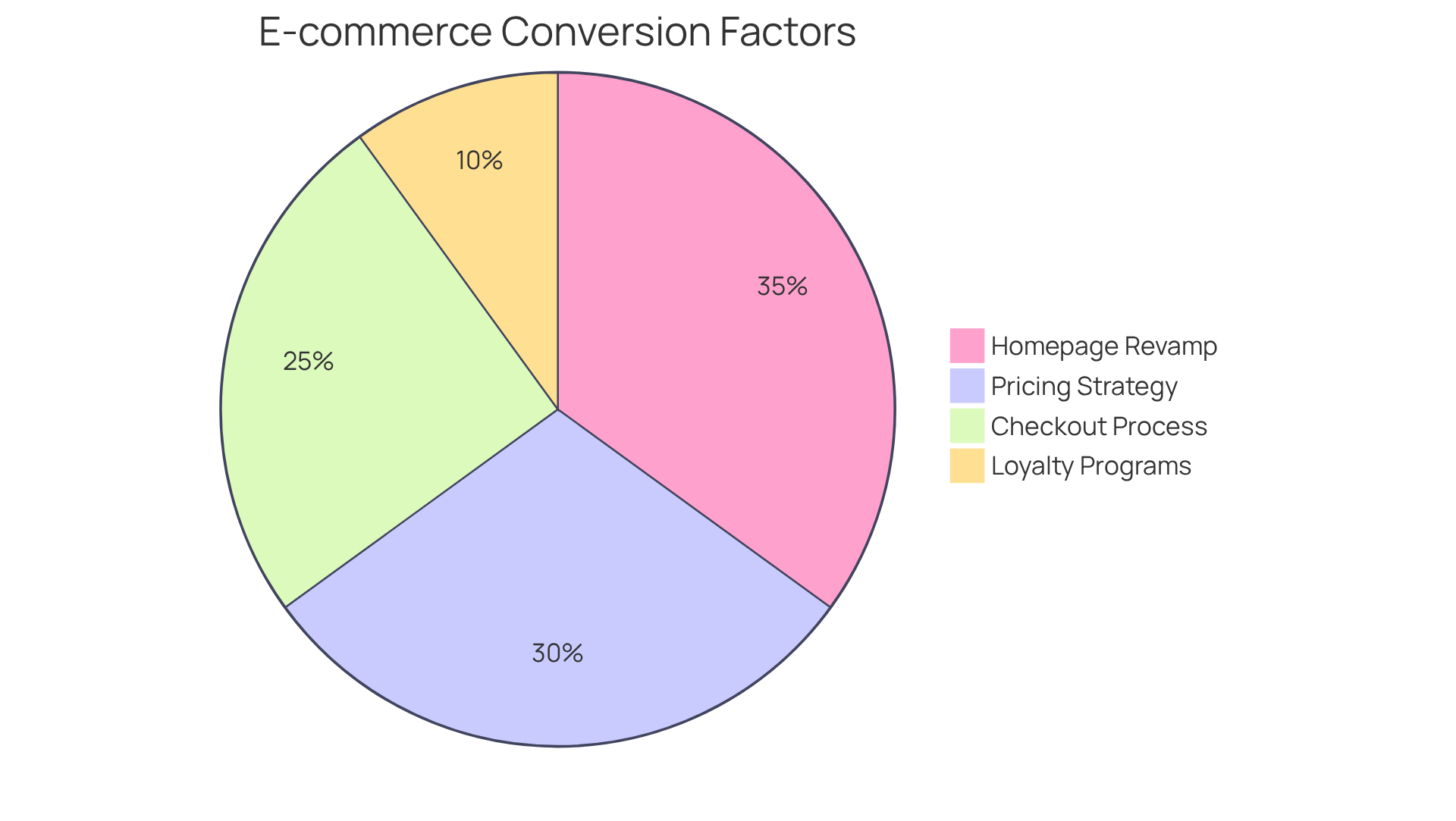
Overview
The article underscores the critical significance of e-commerce conversion rates and the pivotal factors that influence them. A higher conversion rate is not merely beneficial; it is essential for businesses, as it directly affects sales and profitability. Key elements such as:
- User experience
- Product presentation
- Trust signals
- Personalization
- An efficient checkout process
play a substantial role in enhancing these rates. Understanding and optimizing these factors is imperative for any business aiming to thrive in the competitive e-commerce landscape.
Introduction
The e-commerce landscape is evolving rapidly, and conversion rates have emerged as a critical metric for online success. This percentage not only reflects how effectively a website turns visitors into customers but also serves as a vital indicator of a business's overall health and profitability. As companies strive to enhance their performance, understanding the nuances of e-commerce conversion rates becomes essential.
What strategies can businesses implement to boost these rates? Why do they matter more than ever in a competitive digital marketplace? These questions are crucial as we navigate the complexities of online commerce.
Define E-commerce Conversion Rate
The effectiveness of e-commerce can be measured by the e-commerce conversion rate, which quantifies the proportion of website users who complete a desired action, such as making a purchase, signing up for a newsletter, or adding items to a shopping cart. This percentage is calculated using the equation:
(Number of successful outcomes / Total attendees) * 100
For instance, if an online shop attracts 1,000 visitors in a month and 50 of those individuals make a purchase, the purchase percentage would be
(50/1000) * 100 = 5%
This metric is crucial for evaluating the e-commerce conversion rate of an online retail site in converting visitors into customers.
In 2025, the average e-commerce success percentage across various sectors is projected to fluctuate between 2% and 4%. Notably, sectors such as personal care items and food & beverages often outperform others, achieving higher sales success due to the nature of their consumable goods. Conversely, sectors like luxury products frequently experience lower transaction frequencies, reflecting the extended decision-making processes associated with more expensive items.
Understanding these benchmarks helps businesses and identify areas for improvement related to their e-commerce conversion rate. A success percentage of 10% or more is generally regarded as robust across sectors, underscoring the potential for significant revenue growth through effective optimization strategies.

Explain the Importance of Conversion Rates for Businesses
Conversion figures serve as a vital metric for e-commerce enterprises, directly influencing the e-commerce conversion rate as well as income and profitability. An increase in the success ratio signifies that a larger proportion of visitors are completing desired actions, which translates to heightened sales without incurring additional marketing expenses. For example, elevating a brand's success percentage from 2% to 4% effectively doubles sales from the same traffic volume. This improvement is essential in today’s competitive landscape, where customer acquisition costs continue to rise. By prioritizing the e-commerce conversion rate metrics, companies can optimize the yield from their existing traffic, establishing it as a fundamental key performance indicator (KPI) for online retail success.
Looking ahead to 2025, the projected e-commerce conversion rate averages between 2% and 3%, with leading brands achieving figures of 5% or higher. Notably, Parah Group facilitated a $30M clothing brand in revamping its homepage and refining product pricing, resulting in a 35% increase in sales and a 10% growth in revenue per visitor. Similarly, a $15M cleaning product brand experienced an 80% boost in average order value (AOV) after implementing strategic modifications to their purchasing process, such as introducing bundles and multi-packs.
Companies that have successfully improved their transaction success often report significant financial outcomes; for instance, Expedia increased profits by $12 million simply by streamlining their checkout process. Additionally, loyalty programs have shown to enhance sales success, with returning customers achieving an e-commerce conversion rate between 60% and 70%. Furthermore, leveraging user-generated content (UGC) and customer feedback can substantially enhance sales performance, as these elements cultivate trust and credibility among potential buyers. Ultimately, not only elevates revenue but also fosters sustainable growth, empowering brands to thrive in an increasingly competitive environment.

Identify Key Factors Influencing E-commerce Conversion Rates
Several key factors significantly influence e-commerce conversion rates, including:
- User Experience (UX): A seamless and intuitive user experience is paramount. Websites that emphasize easy navigation, quick loading times, and consistently attain higher rates of successful transactions. In 2025, maintaining an exceptional UX is more crucial than ever, as consumers increasingly expect effortless interactions with brands.
- Product Presentation: Effective product presentation can dramatically sway purchasing decisions. Utilizing high-quality images, comprehensive descriptions, and authentic customer reviews not only enhances product appeal but also builds trust. Inviting product pages that promote the 'add to cart' action—currently averaging 11% in the U.S.—are crucial for boosting sales.
- Trust Signals: Incorporating trust signals such as security badges, clear return policies, and secure payment options can significantly alleviate customer concerns. These elements foster a sense of safety, encouraging potential buyers to complete their purchases.
- Personalization: Tailoring the shopping experience to meet individual preferences can greatly enhance user engagement. Customized suggestions and focused advertising approaches appeal to consumers, enhancing the chances of successful transactions.
- Checkout Process: An efficient and user-friendly checkout procedure is essential for minimizing cart abandonment occurrences. Simplifying this phase of the buying journey can result in significant enhancements in success levels, as customers are less inclined to abandon their carts when encountering a clear purchasing experience.
By concentrating on these factors, e-commerce businesses can implement targeted strategies that not only enhance the e-commerce conversion rate but also drive overall sales growth.

Conclusion
Understanding the e-commerce conversion rate is essential for any online business aiming to thrive in a competitive market. This metric not only reflects the effectiveness of a website in converting visitors into customers but also serves as a critical indicator of overall business health. By grasping the nuances of conversion rates, businesses can better strategize their approaches to enhance customer engagement and drive sales.
Throughout the article, key factors influencing e-commerce conversion rates were explored, including:
- User experience
- Product presentation
- Trust signals
- Personalization
- The checkout process
Each of these elements plays a vital role in shaping a consumer's purchasing journey. By focusing on these areas, businesses can significantly improve their conversion rates, leading to increased revenue and profitability. For instance, optimizing user experience and streamlining the checkout process have proven to be effective strategies for reducing cart abandonment and boosting sales.
Ultimately, the importance of e-commerce conversion rates cannot be overstated. As businesses look towards 2025 and beyond, prioritizing conversion optimization will be crucial for sustainable growth. Companies are encouraged to implement targeted strategies that address the identified factors, thereby enhancing their conversion rates and securing a competitive edge in the ever-evolving e-commerce landscape. Taking action today to improve these metrics will not only elevate revenue but also foster long-term customer loyalty and trust.
Frequently Asked Questions
What is the e-commerce conversion rate?
The e-commerce conversion rate measures the proportion of website users who complete a desired action, such as making a purchase, signing up for a newsletter, or adding items to a shopping cart.
How is the e-commerce conversion rate calculated?
It is calculated using the formula: (Number of successful outcomes / Total attendees) * 100. For example, if an online shop has 1,000 visitors and 50 make a purchase, the conversion rate would be (50/1000) * 100 = 5%.
Why is the e-commerce conversion rate important?
The e-commerce conversion rate is crucial for evaluating how effectively an online retail site converts visitors into customers, helping businesses assess their performance and identify areas for improvement.
What is the projected average e-commerce conversion rate for 2025?
In 2025, the average e-commerce conversion rate across various sectors is projected to fluctuate between 2% and 4%.
Which sectors tend to have higher e-commerce conversion rates?
Sectors such as personal care items and food & beverages often outperform others, achieving higher sales success due to the nature of their consumable goods.
Which sectors typically experience lower e-commerce conversion rates?
Sectors like luxury products frequently experience lower transaction frequencies, reflecting the longer decision-making processes associated with more expensive items.
What is considered a robust e-commerce conversion rate?
A conversion rate of 10% or more is generally regarded as robust across sectors, indicating the potential for significant revenue growth through effective optimization strategies.
FAQs











